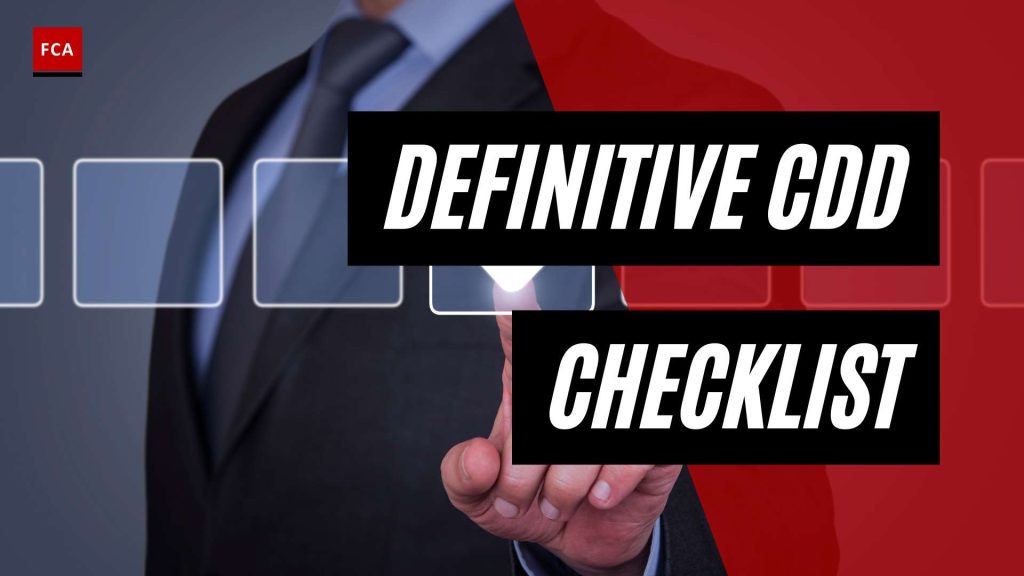Understanding Customer Due Diligence
Customer Due Diligence (CDD) forms the backbone of any robust compliance strategy. Understanding CDD, its importance, and its role in Anti-Money Laundering (AML) compliance is critical for professionals in risk management and financial crime prevention.
The Importance of CDD
A customer due diligence checklist is an important tool for financial institutions to verify their customer’s identity, collect critical information, and assess the risk associated with that customer. Such a checklist helps businesses identify potential risks associated with customers and ensure compliance with regulations such as AML and Know Your Customer (KYC) requirements.
The implementation of a thorough and effective CDD checklist can safeguard businesses from legal and financial risks. It can also help build trust with customers by ensuring the integrity of transactions. This is especially crucial for businesses operating in industries prone to money laundering, terrorist financing, or other financial crimes.
The Role of CDD in AML Compliance
In the context of AML compliance, CDD plays a pivotal role. It involves verifying a customer’s identity, understanding the nature of their activities, assessing the risk they pose, and monitoring the ongoing business relationship. CDD is a critical part of the Know Your Customer (KYC) process, requiring understanding of customers’ identities, financial behavior, and risks related to money laundering or terrorism financing, as mandated by the Financial Action Task Force (FATF).
Companies should adopt risk-based CDD measures in line with FATF guidance to manage AML/Countering the Financing of Terrorism (CFT) risks effectively. For example, low-risk customers may require faster CDD, while high-risk customers, such as politically exposed persons (PEPs) and sanctioned individuals, should undergo more intensive Enhanced Due Diligence (EDD) (ComplyAdvantage).
Establishing customer identity and business activities before initiating a business relationship is crucial to identifying bad actors early. Categorizing customers based on risk levels for future reference in a secure digital location is also recommended in an effective CDD process.
In summary, the role of CDD in AML compliance is not only about fulfilling a regulatory requirement but also serves as an invaluable tool for risk management. For more information on effective AML compliance, refer to our AML compliance checklist.
Implementing a CDD Checklist
Customer Due Diligence (CDD) is an essential process that helps businesses identify potential risks associated with their customers and ensures compliance with regulations such as anti-money laundering (AML) and Know Your Customer (KYC) requirements. In this section, we will detail the crucial steps in a typical CDD checklist, such as verifying customer identity and assessing their risk profile.
Verifying Customer Identity
The first step in a customer due diligence checklist involves establishing the identity of the customer. This is crucial to identify any potential bad actors early on in the process (ComplyAdvantage).
Businesses should gather sufficient information to verify the customer’s identity, including full legal name, date of birth, and valid identification documents. More complex entities, such as corporations, may require additional information such as business registration details, ownership structure, and key controlling personnel.
The verification process can involve cross-checking the provided details with reliable independent sources, such as government databases or credit reporting agencies. It’s crucial to ensure that the documents provided are valid and up-to-date, and any discrepancies should be thoroughly investigated.
Assessing Customer Risk Profile
Once the customer’s identity is verified, the next step involves assessing the customer’s risk profile. This evaluation is fundamental to determine the level of due diligence required and to identify any potential high-risk customers (ComplyAdvantage).
The risk assessment process involves understanding the nature of the customer’s activities, their business model, geographical location, types of transactions, and any potential exposure to politically exposed persons (PEPs) or economic sanctions. This information can help in determining the likelihood of the customer being involved in money laundering or other financial crimes.
Customers should be categorized into low, medium, or high-risk categories based on the results of the risk assessment. High-risk customers, such as PEPs or those targeted with economic sanctions, should undergo enhanced due diligence (EDD) to provide a deeper understanding of their AML/CFT risk.
The process of verifying customer identity and assessing their risk profile is essential for a robust AML compliance program. Implementing a thorough and effective CDD checklist can safeguard businesses from legal and financial risks and help build trust with customers by ensuring the integrity of transactions (Smartsheet). For more information on implementing a successful AML compliance program, visit our AML compliance program guide.
Enhanced Due Diligence for High-Risk Customers
In the realm of Anti-Money Laundering, certain customers present higher levels of risk than others. Such customers require a more rigorous examination through Enhanced Due Diligence (EDD), going beyond the standard customer due diligence checklist.
Identification of High-Risk Customers
High-risk customers may include politically exposed persons (PEPs), sanctioned individuals, and prosecuted money launderers. The identification of high-risk customers typically involves a risk-based approach, such as Know Your Customer (KYC) policies during the Customer Due Diligence (CDD) process.
Factors that can contribute to a customer being considered high-risk include:
- Their occupation or role (e.g., PEPs)
- Their location and country of residence
- Their financial behavior and transaction patterns
- Their involvement in sectors vulnerable to financial crime
By identifying high-risk customers early, organizations can implement the necessary EDD measures and mitigate potential AML/CFT risks, thereby enhancing their AML compliance program.
Steps in Enhanced Due Diligence
For high-risk customers, standard CDD measures may not be sufficient to fully understand and mitigate the associated risks. In such cases, Enhanced Due Diligence steps provide the necessary depth of understanding. The process involves a more rigorous level of CDD scrutiny as part of risk-based compliance (ComplyAdvantage).
The key steps in the EDD process include:
-
Senior Management Approval: Before establishing or continuing business relationships with high-risk customers, approval should be obtained from senior management.
-
Detailed Customer Information: Collect and verify additional information about the customer, their business, and the nature of their transactions.
-
Ongoing Monitoring: Regularly review and update the customer’s information and monitor their transactions for any unusual or suspicious activities.
-
Risk Mitigation: Implement risk mitigation strategies, such as setting transaction limits or conducting periodic reviews.
By applying these steps, an organization can manage high-risk customers effectively, ensuring they meet the requirements of their AML compliance checklist while mitigating financial and reputational risks.
Importance of Ongoing Monitoring
A critical aspect of the customer due diligence checklist is ongoing monitoring. This is a vital step in mitigating risks and ensuring compliance with legal requirements. The monitoring process involves keeping an eye on the continuing business relationship with the customer and adjusting risk assessments as necessary.
Monitoring Transactions
The first step in ongoing monitoring is to observe and scrutinize the customer’s transactions. This includes checking for any suspicious activity that may indicate money laundering or other financial crimes. The nature and frequency of transactions should be in line with what is expected from the customer’s risk profile. Any deviations from the norm must be investigated promptly.
Monitoring transactions is not a one-time task, but a constant process. It’s a crucial part of an AML compliance program, helping to identify possible threats and take appropriate action. Regular transaction monitoring can help to detect unusual patterns early on, allowing for timely intervention and potential risk mitigation.
Updating Customer Information
In addition to monitoring transactions, financial institutions should periodically update customer information. This is necessary to accurately identify and report any suspicious activities. The customer information that should be regularly updated includes:
- Personal details (name, address, contact information)
- Employment details
- Financial situation
- Business operations (for corporate clients)
Maintaining Customer Due Diligence (CDD) records is a common regulatory requirement. Companies should retain all information collected for at least five years, including identification documents and business records.
In conclusion, ongoing monitoring forms an integral part of the anti-money laundering checklist. It facilitates the timely detection of suspicious activities, enables accurate risk assessment, and helps to meet legal compliance requirements. By leveraging AML compliance software, businesses can automate the ongoing monitoring process, making it more efficient and effective.
Penalties of Non-Compliance
Non-compliance with the customer due diligence checklist can lead to severe consequences, both legal and financial. These penalties serve as a deterrent, ensuring businesses take AML compliance seriously.
Legal Consequences for Non-Compliance
Tax return preparers who fail to meet due diligence requirements when claiming tax credits may face steep penalties. For returns filed in 2023, the penalty for each failure is $600, potentially amounting to up to $2,400 per return or claim.
Moreover, employers are not exempted from these penalties. If an employee, who is a tax return preparer, fails to follow due diligence requirements, the Internal Revenue Service (IRS) can assess due diligence penalties against the employer as per the Treasury Regulation section 1.6695-2(c).
Also, in cases where the IRS examines returns or claims for refund prepared by the tax return preparer, a penalty of $500 can be assessed for each failure to meet due diligence requirements. This amount is indexed for inflation, resulting in a $600 penalty per failure for returns filed in 2023.
Financial Risks of Non-Compliance
Aside from the legal consequences, there are also financial risks associated with non-compliance. If due diligence requirements are not met, tax benefits on the client’s return, such as disallowing the Head of Household (HOH) filing status or parts of the EITC, CTC/ACTC/ODC, or AOTC, can result in the client having to pay back any refunded amount in error, along with interest and additional assessed amounts.
The financial risks underscore the importance of having a robust AML compliance program in place. Firms should regularly review and update their AML compliance checklist to ensure they are in line with the latest regulations and best practices. Emerging technologies such as AML compliance software can also be leveraged to streamline and automate the compliance process, reducing the risk of errors and omissions that could lead to non-compliance.
Leveraging Technology in CDD
The rise of digital tools and third-party services has brought significant changes to the way financial service providers approach Customer Due Diligence (CDD). By leveraging these resources, firms can streamline their CDD processes, reduce manual efforts, and improve their overall efficiency and effectiveness in identifying and mitigating risks.
Role of Digital Tools in CDD
Digital tools can play a crucial role in the implementation of an effective customer due diligence checklist. As part of the CDD process, firms are required to perform basic identity verification, assess if enhanced due diligence is necessary for high-risk customers, and maintain updated records (LexisNexis). Digital tools can automate these processes, significantly reducing manual efforts and the likelihood of errors.
Furthermore, these tools can offer advanced features such as searching sanctions lists to help firms determine if they’re restricted or prohibited from working with their potential customers, protecting them from dealing with suspected or guilty individuals or groups involved in financial crimes.
Another advantage of digital tools is their ability to categorize customers based on risk levels for future reference in a secure digital location. This enables firms to quickly access and analyze customer information, facilitating ongoing monitoring and helping to ensure adherence to AML compliance requirements.
Third-Party Services for CDD
In addition to digital tools, third-party services can also be a valuable resource in the CDD process. These services, managed by specialists, can streamline CDD processes for financial service firms, allowing them to focus on growing their business and handling customer relationships effectively.
Companies can engage third parties to conduct CDD processes, including verifying customer identities and beneficial ownerships, under FATF standards (ComplyAdvantage). However, it’s important to note that regulatory responsibility for CDD remains with the company, regardless of any third-party involvement.
By leveraging technology in CDD, firms can enhance their AML compliance program and better manage their risks. Whether it’s through using advanced digital tools or engaging third-party services, the goal remains the same: to effectively identify and mitigate risks, ensure compliance, and protect the firm from potential legal and financial consequences.








